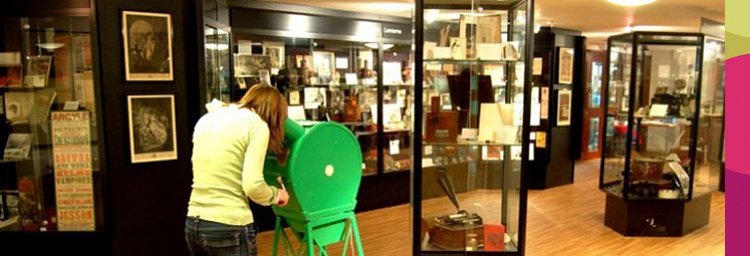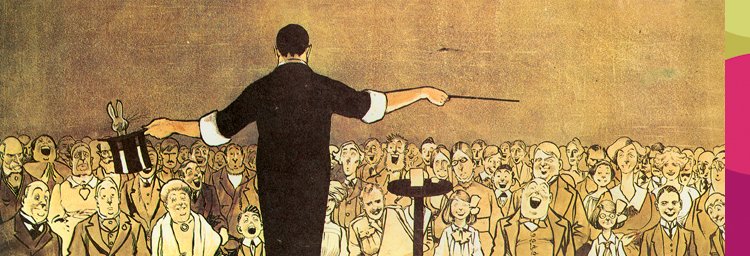
Welcome to the New Year! We are delighted to welcome in 2019 with a splendid new blog from stipend researcher Maria Corrigan, who is an Assistant Professor in Visual and Media Arts from Emerson College in the USA. Maria visited the museum last year when she worked at Concordia University in Canada.
I came to the Bill Douglas Cinema Museum with a simple enough task ahead of me: to explore the archive’s holdings on Charlie Chaplin. Bill Douglas was more than your average Charlie Chaplin fan, and so I was able to peruse a wide variety of items collected lovingly and carefully over a lifetime, from books to sheet music, to copies of fan, film and pop-culture periodicals, to a vast collection of amusing toys, knick-knacks and comic books. The sheer volume of material was not exactly a surprise; anyone who was anyone in the twentieth century wrote about the phenomenon that was Charlie Chaplin, a figure who has been generating buzz for over one hundred years on a global scale that is impressive even by today’s standards. Before the advent of social media, easy content streaming, or portable screens, Chaplin rose to such fame that he accomplished the well-nigh impossible by uniting polar opposites: he amassed untold riches by playing a character who was, by necessity, penniless, became beloved by both mainstream and avant-garde audiences, and appealed to people across the world with a type of comedy that plays upon the personal. My questions upon arriving at the museum were carefully divided between two major lines of inquiry:
1) How did Chaplin’s persona (which includes performances, press coverage, paraphernalia, etc.) code the star as a global phenomenon?
2) How does Chaplin’s specific national identity get enforced in these very same materials?
A partial answer to the first question was immediately provided by the famous Chaplin poster above (EXEBD 56570) that hangs prominently in the Old Library just outside the Museum itself.
In this French publicity poster from artist Ruy Leymarie, a laughing Chaplin sits astride the planet. “Charlot” is not simply a global phenomenon, but is poised for world domination. This approach to Chaplin as a global icon figures (either prominently or obliquely) in the writing and toys that have collected around the star figure. Consider the similarities to the cover for Gerhard Ausleger’s 1924 book on the star [EXE 46008], illustrated by Rudolf Ausleger.


In another piece of Chaplin paraphernalia above [EXEBD 68327] from the United States made in 1979 (and in Taiwan), Chaplin is represented as one of 12 masks, advertised as “Masquer-aids.” Here, the Chaplin mask is an identity just as recognizable as police officer, Marilyn Monroe, clown, and a host of international, Asian, and Roma identities which read today as outdated as far as costuming goes. Whether or not Chaplin and Monroe’s star power are comparable is not the question here; rather, both stars seem to enter into an economy of icons that become equatable with easily identifiable uniforms and ethnic or racial types.
To be fair, Chaplin’s costume is easy to identify and just as easy to put on. Chaplin had only been working in cinema for a year when Charles McGuirk likened his fame to a virus; “Chaplinitis” was spreading wildly, with everyone attempting to mimic the manners, the comedy, and especially the waddle of the “inimitable Englishman.” McGuirk’s comments are echoed by a number of postcards in the museum’s collection that focus on his impersonators, from images that illustrate Chaplin beset by a number of imitators [EXEBD 86100]

to another, prominently displayed in the Museum, that testifies to the desire to imitate the “funny ways and feet” of the man who has everybody going “Chaplin mad.” [EXEBD 86096].

This virulent fandom ambled its way into songs and sheet music as well, with Nat D. Ayer’s “That Charlie Chaplin Walk” and Theo Bonheur’s “Charlie Chaplin’s Frolics” (to name just two) [EXEBD 50280 and 50281].


And yet despite this proliferation of Chaplin images, impersonators, and stories (for more on Bill Douglas Cinema Museum Chaplin comic book holdings, follow this link: https://soundcloud.com/user-129291695/chaplin-comic-books), the Picture Show Art Supplement from 1926 reminds us “there is only one Chaplin.” [EXEBD 43987]

A lion’s share of the writing about the slapstick supernova focuses on the remarkable split between Charlie, the little tramp, and Chaplin, the director and creator. This divide is the subject of simple biographies, like Claude Jean-Philippe and Patrick Lesueur’s Saint Charlot and Mister Charles [EXEBD 46093]. It is also a constant theme in the more scholarly and theoretical works devoted to Chaplin (so much of which can be found in the museum’s holdings, and in multiple languages).

Of the many oppositions that tear Chaplin into two distinct and competing identities (Tramp/Creator, pauper/millionaire, clown/artist, innocent suitor/predator upon young women, persona/man), I only have space here to elaborate on one: Chaplin as universal hero/Chaplin as national citizen. Produced painstakingly on screen, the first Chaplin seems to detach himself from a distinct filmography to lend himself to a steady stream of imitation. This Chaplin belongs to everyone, everywhere, floating carelessly and whimsically along the edges of a national framework. The endless proliferation and reproduction of Chaplin’s little tramp is autonomous and different from the second Chaplin; the exacting director who rehearsed gags to perfection and destroyed imperfect footage could not control the narratives that Chaplin, the persona, stumbles into in the comic books of 1915. Nor could Chaplin anticipate images such as EXEBD 76113, a flyer picked up in a Soho Street in 1995, featuring an illustration of a woman in Chaplin drag (and labelled by the museum “Prostitute’s publicity card: Darlings – Chaplin.” [EXEBD 76113].

All of the examples and images above seem to testify to Chaplin as a type of template or framework that can be animated and manipulated by other people’s creative needs and directions.
The second Chaplin—I hesitate to call him the real Chaplin, but perhaps the historical Chaplin could work—never experienced the universal ease that his creation enjoyed. He did not live in a frictionless, borderless world that effortlessly delivered his star image to audiences across the globe, but was instead constantly defined or examined from within a national lens. As a North American scholar, I was particularly curious to examine the museum’s holdings for evidence of how Chaplin, whose fame and persona depended upon leaving England behind, was then claimed by England as a national hero. Both Chaplins are immigrants, after all, but only one of them was able to transform this status into poetic outsider. How was Chaplin treated in his home country?

EXEBD 74595 Chaplin Talc Bottle

EXEBD 10887/1 Box showing Chaplin models in front of Stonehenge.
The answer is, of course, variably and always dependent upon the historical moment. Take, for instance, the account published in the 1917 The Chronicles of Charlie Chaplin: Based on the Essanay-Chaplin Photoplays (EXEBD 46011) where Langford Reed likens Chaplin to the national institution of World War I. The same book includes the appreciative letters sent by soldiers to the Essanay Company, including the following:
GENTLEMEN.—I have to thank you for the letter of September 11th, forwarded to me to-day, and for the gift of films.
It is impossible to make you realise how they were appreciated, and I truly wish you could have heard the cheer that went up when Chaplin appeared on the screen.
The posters—i.e. cardboard figures of Chaplin—were carried off during the night to the trenches, and have been the subject of great attention by the Allemands!
W. Murphy, Major, A.S.C.
The museum’s collection of the weekly periodical Illustrated gives a sense of how, by the 1940s and 1950s, Chaplin’s national usefulness had ebbed and flowed. In the May 17, 1947 issue, an article matter-of-factly lists his four marriages along with the ages of all four wives at the times of the union (15, 16, 23, 18). [EXEBD 21679].

This alone may not sound critical, but one can track a remarkable change of tone between this period and the series of Illustrated pieces that surrounded Chaplin’s third visit “home” in 1952, a critical moment for Chaplin, since his re-entry permit to the U.S. was denied during this very trip. In the September 20 issue of that year (EXEBD 21681), journalist Hannen Swaffer prepares Illustrated readers for what would certainly be a “return of a national hero.” Chaplin’s previous visit in 1931 had cost him some measure of British good will, after he, at the “high-spot of his glory,” stood up both Prime Minister Ramsay McDonald and the people at the Hanwell orphanage “of which he was an ‘old boy’.” The very next week, Illustrated devoted an article to the “Life and Loves of Charlie Chaplin,” but gone is any judgmental tone over his love life, with Chaplin presented as redeemed by the bliss and abundance of his last marriage to Oona O’Neill.
Whether or not this visit restored to him the popularity he enjoyed upon his first visit home in 1921, Chaplin has remained a national monument, even while monuments and museums have been erected in his honor in Great Britain and across the globe. It is perhaps instructive to examine the decidedly cool obituary in the London Times on Wednesday, December 28, 1977 (EXEBD 29376) to see how this national hero, “loaded with honours and universally regarded as one of the unshakable monuments of the cinema (whatever controversy his political attitudes might arouse)” was eulogized: “As we moved into the 1950s it became permissible to prefer the refined and unsentimental art of Buster Keaton, who was certainly a far more subtle and imaginative filmmaker than Chaplin could ever claim to be, or even the totally unpretentious humour of Laurel and Hardy.”
In summation, I was able to unearth an extraordinary amount of information, curious details, and delightful memorabilia that helped to clarify my two central questions. I am grateful to the Bill Douglas Cinema Museum for their support in this research that will allow me to pursue these questions in a larger project that focuses more specifically on the productive ambiguities of Chaplin’s national, political, and ethnic identities that, in turn, allow the figure to operate as a global icon.





